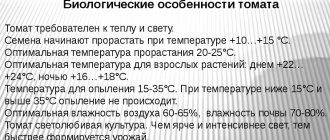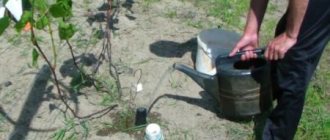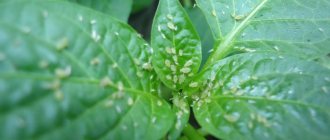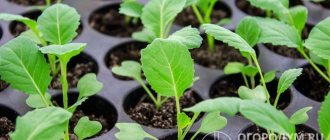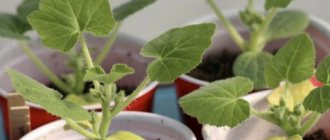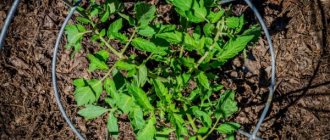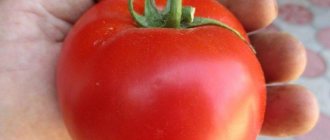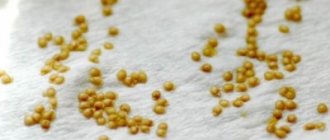Watering schedule
The frequency of watering seedlings during the day and week and the rate of water consumption primarily depend on the conditions in which the tomatoes grow. However, there are several rules that are common to everyone when growing this crop:
- The first watering of the soil should be done when sowing the seeds. It is necessary to water the soil well so that it becomes deeply moistened and the seeds germinate faster. Then seeds are sown on top of the wet soil and sprinkled with dry substrate. Until the first shoots appear, there is no need to water the tomatoes anymore! To reduce moisture evaporation, it is best to cover the container with film. This will create a greenhouse effect, and the seeds will hatch faster in moist soil.
- When a couple of days have passed after the first shoots appear, you need to carefully water the tomatoes a second time. You need to water the sprouts very carefully, trying not to let the drops fall on the leaves. Watering should only be at the roots. Increased moisture on the leaves will damage the fragile seedlings.
- The further watering schedule depends entirely on the drying of the soil. If the seedlings are on a south-facing windowsill, you will have to water more often. On the east side there is no need to flood the tomatoes too much. Plants should not be overdried, but at the same time the substrate should not be allowed to become waterlogged.
It is very important to use long-settled warm water for watering tomato seedlings. Cold tap water can cause stress in still immature seedlings, and they can get sick.
It also matters when to water the seedlings. So, on a southern windowsill you need to do this in the evening. On the eastern window, you can add water to the sprouts in the morning.
Methods of watering at home
The most effective and popular methods of watering tomato seedlings are irrigation from a spray bottle, watering from pipettes and other small containers, as well as drip and wick humidification.
Types of watering tomato seedlings:
- Drip - with its help, moisture is supplied in measured volumes, without drying out or waterlogging the soil. You can make a drip irrigation system yourself using a regular plastic bottle, a silicone tube and a clamp for medical droppers. Secure the bottle slightly above the seedling container, lower one end of the tube into the bottle, and deepen the other 4-5 cm into the ground. Control the speed and volume of incoming liquid using a medical clamp.
- Wick - this method is used when growing tomato seedlings in separate cups or pots. While filling the container with soil, pass the wick through its drainage hole, leaving a short edge in the soil. Place the seedling container in a cut plastic water bottle and dip the free edge of the wick into it.
The main advantage of drip irrigation is the ability to water several containers with tomato seedlings from one bottle at once.
As a wick for the second method, you can use a regular nylon cord with a length of at least 15 cm. The advantage of wick watering is that the growing seedlings will be able to independently “extract” the amount of moisture that is necessary at this stage of development.
Watering after picking
About three days before the planned picking of tomatoes, the seedlings are watered at home. You should water the tomatoes very generously so that the soil mixture becomes deeply moistened.
After this, the seedlings are no longer watered from above. Is it possible to water through a tray? It is even necessary to water through a tray. This way you can force the roots of the sprouts to stretch deeper, which means they will become stronger and the plants will be able to develop a powerful root system.
After picking, the stronger tomatoes begin to be watered again at the root as the substrate dries. You need to use only settled warm water and try not to get it on the leaves when watering.
Subsequently, the tomatoes are watered in the usual way until they are planted in the ground as needed.
Formation of tomato
Indeterminate and semi-determinate hybrids are grown in 1 or 2 stems. When forming into 1 stem, all lateral stepsons are removed, leaving only the main shoot. If there are 2 stems, then one of the strongest stepsons is left as the second. It, like the main stem, is tied to a trellis, removing all the side shoots (when forming 2 stems, tomatoes are planted less often, since in the future two will be obtained from one plant).
When growing determinate varieties in low film shelters, they are often formed into 2 stems. If grown in high greenhouses, then medium-sized (determinant) tomatoes are formed into one stem; when pinching, the upper strong stepson is always left, which later serves as a continuation shoot. Then from this stepson at the top a stepson again appears, he again is a continuation for growth. It is twisted around the twine. Thus, the plant seems to grow upward due to the upper stepson. You need to carefully monitor the tomatoes and always leave a reserve shoot at the top of the plant.
By the time the fruits on the first cluster are filled, the lower leaves begin to turn yellow and are periodically torn off. The lower leaves must be removed before the inflorescence, on which the fruit begins to ripen.
30–40 days before the end of cultivation, the main stem is pinched (otherwise the fruits in the upper part of the plant will not have time to ripen).
The lateral shoots are removed - when they overgrow, they shade the plants and waste their energy in vain.
It is better to remove stepsons in the morning, when they break off easily. The columns from the stepsons are left 2–3 cm high.
Back to contents
Watering after planting
A couple of days before planting the seedlings in the ground, watering is stopped. Then, a couple of hours before planting, the tomatoes are well filled with water to soak the roots and injure them less. When planting, the seedlings are also well moistened, and the soil around each bush must be mulched to reduce moisture evaporation.
Tomato seedlings grown on a windowsill indoors are very vulnerable. That is why in the middle zone gardeners often plant it in a greenhouse. The rules for watering plants after planting in the ground change, but, in general, gardeners adhere to the main rule of watering seedlings - it is necessary to moisten the soil as it dries.
After planting, seedlings should not be watered for two weeks. Next, very abundant watering is carried out. For each bush you need to spend about 10 liters of water. The frequency of watering should be moderate, as this crop does not tolerate dampness. It is enough to water the planted tomato seedlings once a week.
When watering, you should not pour water on the tops, as this will inevitably lead to disease. Most often, tomatoes suffer from late blight, which occurs precisely because of excessive dampness.
How to grow healthy tomato seedlings?
ilbirs
1. buy good soil for growing seedlings of tomatoes and peppers - this is half the success 2. buy good varieties of tomatoes (preferably in specialty stores, and not just anywhere) 3. observe the timing of sowing seeds (late-ripening ones are planted earlier, in March, early-ripening ones - in April) 4. tomatoes love light! place for seedlings is the south side, they do not like the proximity of cucumbers (they oppress each other), they are responsive to fertilizing (Kemira Lux) 5. to form a powerful root system after 2-3 weeks (the frequency of watering depends on the growth rate of the seedlings), water with atlas. Have a good harvest!
Em
What is wrong with your seedlings? I grow small tomatoes first on the windowsill, even before flowering. The most important thing, believe me or not, is to treat the sprouts as if they were a living being - with care and love. Never think bad things around her. Then she will be strong and healthy.
Svetik
Well, after Ilbirs’ answer there is nothing to add. I also grow my own pepper and tomato seedlings every year. And I came to the conclusion that planting too early is not suitable for me. Last year I sowed peppers in February, they took a long time to germinate, as if they sensed that spring was not coming soon, then another variety in March. By the time the seedlings were planted, they were equal in height. I sow tomatoes in March. Peppers immediately into separate cups. Tomatoes definitely require picking and planting. It is advisable even 2 times, first from one container separately, and then in April - into a larger glass. With each transplant they only become stronger. But I usually have a lot of them, about 50 of them, there is not much space on the windowsills, so I dive once. South window, also fertilize with KemiraLux or Malyshok for tomatoes. And it’s also important not only to grow good seedlings, but also to protect tomatoes from late blight in the garden beds. Here the ProfitGold product helps me, 3 times a season and I don’t get sick. Good luck to you.
Feeding tomato seedlings during watering
Seedlings definitely need nutrients for proper growth and rapid development. To do this, watering young plants is combined with fertilizing. Nitrogen is especially important for seedling development.
It is on this substance that the following depend:
- stem thickness;
- saturation of foliage color;
- its juiciness.
A lack of nitrogen will lead to thinning of the seedlings - they will become pale and very weak.
Phosphorus is also important, which gives tomatoes energy to grow, promotes flowering and fruit formation.
But you cannot overdo it with adding nutrients, even if the seedlings are fed with folk remedies that are harmless. An excess can lead to the death of seedlings.
How many times should you feed tomato and pepper seedlings:
- The first time feeding is added to the tomatoes after the appearance of 3 true leaves.
- The second fertilizing is applied after picking, two weeks after applying the first fertilizer.
- Before planting seedlings in open ground, it is necessary to feed the plants again 10 days before the planned date.
For the first time, the seedlings should be fertilized with complex fertilizers that contain a lot of nitrogen. You can prepare the nutritional mixture yourself by mixing:
- 5 g potassium salt;
- 0.5 g urea;
- 4 g superphosphate.
All components are stirred and dissolved in 1 liter of water. The second time the seedlings are fed only with urea.
Along with tomatoes, many gardeners grow pepper seedlings. Pepper seedlings need to be fertilized with complex fertilizers. They should contain a lot of nitrogen for the strength of the stem, as well as phosphorus for the root system. After planting in the ground, it is enough to add complex mineral fertilizer to the bushes.
There are foliar feeding of seedlings and root feeding. Root fertilizers are applied directly under the root. The second is sprayed onto the leaves. For the first time, seedlings are added only to the root so that the root system develops faster.
Gardeners often use manure to keep seedlings strong. In this case, a bucket of manure is dissolved in 3 buckets of water. When the composition sits for a day, each bush is watered with it. Fertilizing with yeast also gives good results.
Features of irrigation with fertilizers
Once every 3–4 weeks, it is allowed to add fertilizers to the water, followed by watering the seedlings and directly strengthening them. For this, special mineral complexes or organic substances, for example, mullein or sifted wood ash, can be used.
In the first case, it is important to maintain the ratio of the complex to water (no more than 1 to 10), since an excess of the chemical composition can cause burns and further damage to the root systems of the seedlings. In the situation with mullein and wood ash, it is necessary to use clean, settled liquid (a liter of substance per bucket of water). Watering should not be done to the root part of the soil, without touching the green leaves and stems.
Fertilizing mode
In order for a vegetable crop to develop properly, the soil for its growth must contain all the necessary nutrients. When applying fertilizing, it is important to take into account the developmental characteristics of the plant. Indeed, depending on the growing season, the need for nutrients changes, as does the fertilizer application regime.
It is important not to skip fertilizing during the following periods:
- when 2-4 true leaves are formed;
- during the budding period;
- during the formation of ovaries;
- during fruit ripening.
To speed up the growth of seedlings and grow strong bushes, fertilizers should be applied several times during their growth. The first time is fed during the growth of sprouts, then before picking, then before planting in open ground.
If the seedlings show a lack of nutrients, additional fertilizing can be applied. In this case, additionally fertilize with complex mixtures. Typically, gardeners feed seedlings every 15 days.
Strong and strong tomato seedlings are the key to a rich harvest. When watering and applying fertilizers, you must first focus on the condition of the plants. If the seeds were sown in nutritious fertile soil according to all the rules, then it is possible that you will not have to feed the crop so often.
Additionally, after planting the seedlings in the ground, foliar feeding is necessary. It is more difficult for plants to obtain nutrients from the ground than from the leaf plate, so to obtain faster results, gardeners use spraying with nutrient solutions.
To have good tomato seedlings, how often should you water?
Tomatoes are considered one of the most popular garden crops.
They have gained such popularity due to their nutritional qualities and dietary properties. However, the huge variety of varieties requires different growing methods. In order for tomato seedlings to germinate well, how often to water them is a very important point. Tomatoes can be cultivated both in soil protected with film coverings and in the open air. Skilled gardeners grow tomatoes on window sills and balconies.
How to choose the right place to land?
Tomatoes love warm conditions, the best temperature values for them are +22...+24 °C, a little lower at night (+17...+18 °C). Tomatoes must be protected from the slightest frost, otherwise they will die. When growing tomatoes, you should make sure that they are illuminated in sufficient quantities by the sun.
When to plant?
When growing tomato seedlings, how often to water them is a very important question, since tomatoes love moist soil. It is necessary to plant seedlings only after frosts have ended; they are detrimental to tomatoes. When the soil warms up to approximately +10 °C, planting can begin.
The subtleties of growing tomato seedlings
It is better to prepare the soil yourself so as not to doubt its quality. Tomatoes are not very demanding on the composition of the soil, so it will be enough to combine humus, turf soil and peat in equal quantities. They must first be sifted to separate the debris. There is an opinion that it is advisable to steam the soil, but many experts do not recommend doing this, believing that in this case all beneficial bacteria will die.
Seed preparation
It is necessary to prepare seeds for seedlings, but it is not necessary to germinate them. Tomato seeds must be soaked in a solution that is a growth stimulator. It is better to grow them in small containers about 8 cm high. You should not place tomatoes of different varieties next to each other, as they may not take root.
If the temperature in the room where the seedlings are located is +25...+30 °C, then the period of seed germination will be about a week. The duration of growth is also influenced by factors such as the quality of the raw material and the duration of its preliminary storage and preparation. Therefore, germination times can range from 4 to 20 days.
After everything has been sown, the containers should be covered with polyethylene film or glass, and then placed in a warm place, not far from a heat source.
When the first shoots appear, you need to remove the cover from the container and move the seedlings to the brightest place. First, the temperature values must be reduced to +12 °C, and at night - to +10 °C. Then the temperature must be raised to +19 °C. Before picking, caring for seedlings consists of watering and loosening the soil. Watering tomato seedlings should be done with settled water. In order for the sprouts to become strong and strong, in the first days it is necessary to provide them with additional lighting, which should be provided 14-18 hours a day.
Approximately 20 days after sowing, the first leaves will be visible. It is very important to plant the sprouts in separate containers in time to prevent overgrowth.
You should not expect a large harvest from weak sprouts, so picking should start with strong seedlings. Using a special peg, you need to make a small depression and carefully place the seeds in the soil to the level of the leaves, and then press tightly with earth.
During this period, it is important to create optimal conditions for seedlings: temperature values should be +18...+19 °C, and at night - several degrees lower. The thermometer must be placed near the container with seedlings. To have good tomato seedlings, how often to water, how to fertilize and where to place - these are the main nuances.
After a week, you need to carry out the first fertilizing with mineral fertilizer, and then repeat it every 10 days. Now, watering tomato seedlings with warm water, loosening the soil and adding soil mixture are the basic rules for caring for tomatoes. The sprouts will be attracted to the light, so the containers must be turned regularly.
Watering tomatoes
While the tomato seedlings are growing, every experienced gardener knows how often to water. Watering should be even and regular so that the leaves do not overheat. It is advisable to mulch, and the stream of water should be directed to the center of the row spacing so as not to damage the plant. It is worth watering before lunch, but there is no need to wait until the leaves begin to fade.
The best way to water tomato seedlings is something everyone who decides to achieve good results and grow delicious tomatoes needs to know. The water must be settled, preferably filtered, and it must be heated to room temperature.
10 days before transplanting tomatoes, you need to slightly limit watering and gradually accustom the sprouts to the rays of the sun. During the day, you can keep the container in the greenhouse, and in the dark, move it outside.
How to properly water tomato seedlings before planting - it depends on the weather. If it is very hot, you need to make sure that the leaves receive enough evaporation so that they do not dry out.
fb.ru
Do I need to prick out the sprouts?
If previously no one was particularly tormented by doubts about whether it was necessary to pick tomato seedlings, now gardeners are very consciously approaching the matter. The opinions of experienced vegetable growers here are extremely polar. Some believe that it is impossible to do without this in order to reap a decent harvest. Others claim the opposite - it is better to plant tomato seedlings without picking, and that’s all. The main thing is to weigh the many pros and cons to understand whether it is possible to do without this procedure or not. In accordance with this, it is necessary to choose the appropriate method of sowing seeds and further caring for them.
Proponents of the tomato thinning procedure believe that it is an integral part of tomato agricultural technology at the seedling stage. They don’t even understand those who ask whether it is possible not to pick tomato seedlings or not. And they even do it more than once during the growth phase of young seedlings.
Opponents of this technique claim that picking tomato seedlings at home is accompanied by the loss of part of the root, which in young bushes is very thin and almost invisible to the eye. It takes a certain amount of time (about 10 days) to restore the wounded root system. But they know how to grow tomato seedlings without picking, and this is many times better for the plants. Therefore, everyone must decide for themselves which growing method for seedlings will be preferable. Often such awareness comes through long experience.
What is the procedure to be performed?
The undertaken picking of tomato seedlings at home involves planting young plants in their own containers or thinning out the shoots in one large container. The seeds are sown thickly, in the hope that most of them will germinate. Such thickening of plantings is not suitable for the full development of each bush. And it even threatens to result in stretching of seedlings and some diseases. Lack of light will weaken the shoots, which will cause low yields in the future.
For these reasons, seedlings are transplanted. However, many are interested in how to properly plant tomato seedlings, since the procedure is usually carried out in a chaotic manner due to inexperience. It is about the sequence and when it is better to plant tomato seedlings that we will talk further.
When is the best time to start a transplant?
You should wait until two true leaves appear after the cotyledons, and then you can safely get down to business.
Plants planted early may not survive, and late replanting will affect the vigor of development of the sprouts - they will become sluggish, their growth will stop for some time.
You should determine the date when you need to pluck tomato seedlings yourself. However, approximate days are indicated that experienced vegetable growers are guided by - these are 5 or 12 days after sprouts peck. By this time, the seedlings will become a little stronger, and their roots will strengthen.
The timing for each tomato variety is different; it also depends on the fertility of the soil. Sometimes it is not worth delaying until the 12th day, so as not to wait for the already grown seedlings to outgrow, the roots of which can already be up to 15 cm. In this case, the seedlings can already be considered somewhat overgrown for the first picking. Sometimes seedlings grow weakly and only by the 12th day do they barely have time to produce their first leaves. Therefore, the optimal time for picking a tomato in each specific case is determined as the true leaves come out.
When carrying out a transplant according to the lunar calendar, you should find the closest favorable date and carry out seating on that day.
Favorable days for planting tomatoes for greenhouse cultivation in March: 9-11, 14,15,18,19.
To grow in the exhaust zone, tomato seedlings are picked in April in the following numbers: 13, 14, 16, 17, 20, 21, 24, 25.
The time criterion is now known, then we will consider how to perform the procedure and how to care for tomato seedlings after picking or transplanting.
How to plant tomato seedlings?
Begin transplanting seedlings by preparing containers of the appropriate volume. For these purposes, you can choose any containers with a capacity of 200 ml, planting containers with a depth of at least 15 cm, and special trays with recesses. Preparing the soil mixture is the next step when picking tomatoes.
Knowledgeable vegetable growers have been harvesting fertile soil from the plot since the fall. The soil mixture is prepared as follows: mix turf soil, humus (or peat), and sand in equal parts.
The entire process should be carried out with cotton gloves, since the temperature of human palms is higher than that of the seedling shoot. Protecting your hands with a cloth will prevent the development of a shock reaction in young plants. Using a spatula to dig up the seedlings helps reduce the number of touches to the bushes and keep the rhizome intact.
After removing the sprout from the previous container, a part of 4-5 cm is pinched off from the main root from the very bottom, and the seedling is sent to a moistened, freshly dug hole to a new place of growth. The bush is buried at a distance to the cotyledon leaves. After planting, the soil near the stem is compacted with your fingers and slightly moistened. Now we know how to pick tomato seedlings. Often, beginners are interested in how many times it is considered normal to pick tomato seedlings. And they do it right. After all, the first picking of tomato bushes may be followed by a second.
